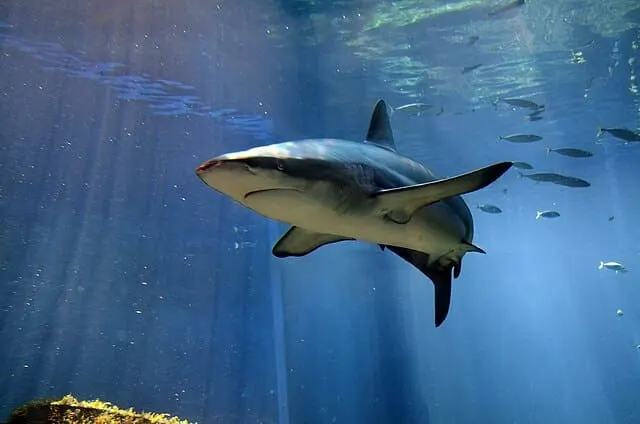Welcome to Shark Attacks in New York.
Six shark attacks have occurred on Long Island in the last three weeks, resulting in media attention and anxiety for surfers and swimmers.
Continue reading to learn all about shark attacks around New York, and how to keep yourself safe.

Everyone at the beach feels a little more uneasy due to recent shark sightings and attacks. On July 13, 2022, NBC News reported two shark attacks in one day.
Even now, fatalities from shark attacks are still incredibly uncommon. One in 4.3 million people die from shark-related causes, compared to one in 84 people who die in motor vehicle accidents. Is this just hyped-up business as usual? And if so, what’s going on?
Do more sharks exist due to practical conservation efforts or the warmer waters brought on by climate change? Or are sharks—which transcend dinosaurs, just taking back the land that is rightfully theirs?
New York Shark Species
The oceanic seas off New York are home to numerous shark species. Sharks can be as small as 4 feet, like dogfish sharks, or as large as 40 feet, like basking sharks. Sharks’ biological traits, such as the prey they consume and their hunting techniques, can also vary substantially.
#1 Basking Shark
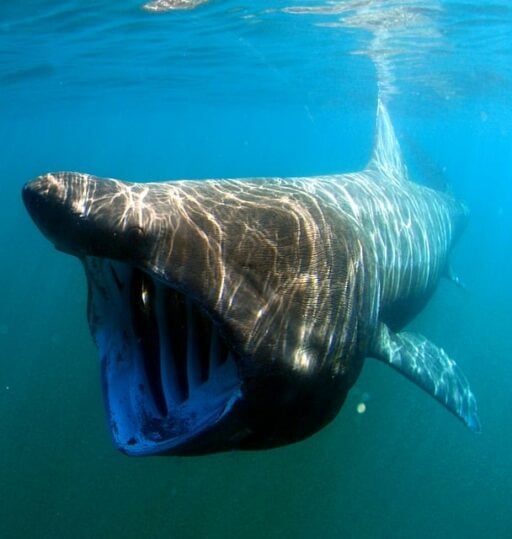
Scientific Name: Cetorhinus maximus
They are up to 40 feet in size and mainly settle offshore, usually close to the surface. The basking shark filters food by eating zooplankton. The basking shark is a sluggish swimmer and reaches lengths between 16 and 20 feet (in 12 to 16 years).
It has a lifespan of 50 plus years. The basking shark has a 3-year gestation period and is ovoviviparous, and gives birth to a few live pups. (This one won’t attack anyone).
#2 Blue Shark
Scientific Name: Prionace glauca
They are up to 12.5 feet in size and mainly reside offshore.
Although the blue shark typically swims slowly, it can move swiftly. It feeds on tiny fish and squid. Usually, it grows 6 and 7 feet in length (4 to 7 years) and has a 20-year lifespan.
The blue shark is viviparous, meaning that the female carries live offspring fed by the placental yolk sac until the little ones are completely formed.
Her litters typically contain approximately 30 pups. Gestation lasts 9 to 12 months. (This one won’t likely attack anyone).
#3 Common Thresher Shark
Scientific Name: Alopias vulpinus
The shark is typically found offshore or in coastal waters and can grow up to 25 feet long. The common thresher shark gathers schools of fish and stuns its prey with its massive caudal fin (their tail). They can swim very well and have been seen to leap out of the water occasionally.
They feed on small schooling fish like sand lance, bluefish, butterfish, menhaden, and mackerel. When mature, the shark becomes 10 to 15 feet (8 to 12 years) and has a lifespan of 45 to 50 years. It gives birth to two to four puppies after the gestation period, which is a year long. Like most sharks, it is ovoviviparous.
(This one won’t likely attack anyone).
#4 Dusky Shark
Scientific Name: Carcharhinus obscurus
The shark is typically found offshore or in coastal waters and can grow up to 14 feet long. Fish with bones and cartilage, cephalopods, and crustaceans make up their diet. They mature slowly and grow very gradually.
The dusky shark lives up to 45 years and reaches maturity at about 9 feet (16 to 23 years). The dusky shark’s young are fed by the placental yolk sac until adulthood, meaning they are viviparous.
There are typically 3 to 14 puppies, and the gestation period is 22 to 24 months. (This one could attack).
#5 Sand Tiger Shark

Scientific Name: Carcharias taurus
Offshore and coastal areas make up the sand tiger shark‘s habitat. This shark frequents the estuaries on Long Island, particularly Great South Bay, which serves as a summertime nursery for young sharks.
The shark is about 10.5 feet long. It feeds on crustaceans, cephalopods, and fish with bones and cartilage.
The sand tiger shark reaches a length of 6.5 feet (6 to 10 years) and has a lifespan of at least 15 years. The shark gives live birth to one to two pups and is ovoviviparous. A process known as adelphophagy occurs during gestation, meaning that the furthest developed embryo in each uterus consumes the embryos that are less developed.
Gestation lasts between nine and twelve months. (This one could attack).
#6 Sandbar Shark
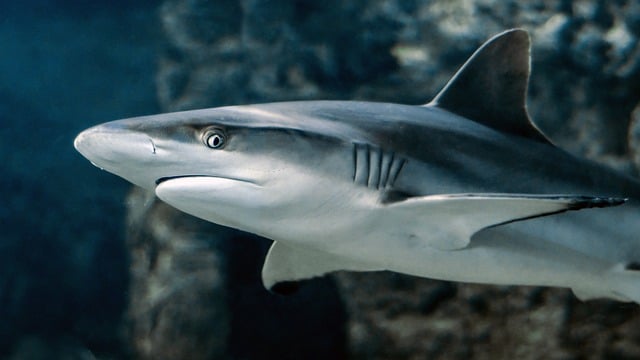
Scientific Name: Carcharhinus plumbeus
The brown shark, sometimes called the sandbar shark, lives in offshore and coastal areas and can reach a maximum length of 8 feet. It feeds on small bottom fish and crustaceans like blue crabs, dogfish, goosefish, skates, and rays.
It has a lifespan of 20 to 30 years and reaches maturity at 5 feet (15 to 18 years). Shark mothers are viviparous, meaning they give birth to living young fed by the placental yolk sac until they reach adulthood. There are typically eight pups in each litter. (This one could attack).
#7 Shortfin Mako Shark
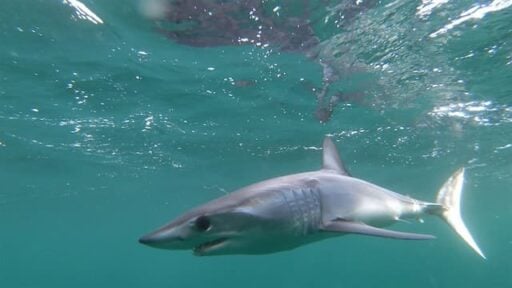
Scientific Name: Isurus oxyrinchus
The 13-foot-long Mako shark is typically found offshore and can grow quite large. It is the fastest shark in the entire animal kingdom, with bursts of swimming speeds reaching up to 43 mph.
It consumes pelagic species that move quickly, including swordfish, tuna, billfish, other sharks, squid, and bluefish.
The Shortfin Mako shark has a 20-year lifespan and matures when it is between 6.5 and 9.5 feet long (8 to 18 years). The shark gives birth to 5 to 10 pups and is ovoviviparous. (This one could attack).
#8 White Shark
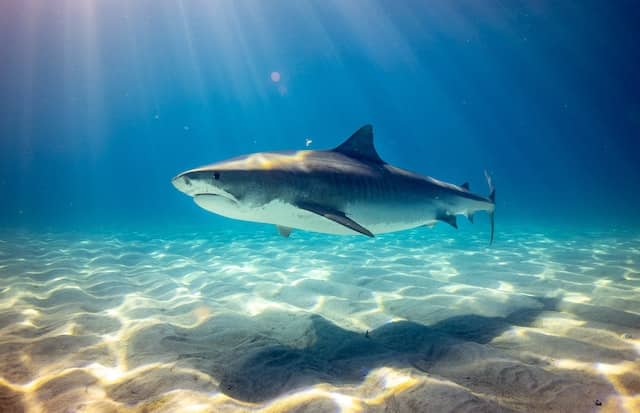
Scientific Name: Carcharodon carcharias
During the warm season, juvenile white sharks use the coastal ocean off Long Island as a nursery habitat. They can be seen offshore or in coastal waters. These ambush predators and powerful swimmers are known as white sharks.
Young fish are their primary meal, devouring bony and cartilaginous fish. Adults (those over 10 feet long) eat seals, other sharks, and rays – and are even rumored to eat dead whales. They have a lifespan of 70 years and achieve maturity at about 10 to 16 feet (26 to 33 years).
They give live birth to small litters of pups and are ovoviviparous. (There is a high chance this one could attack).
#9 Great White Shark
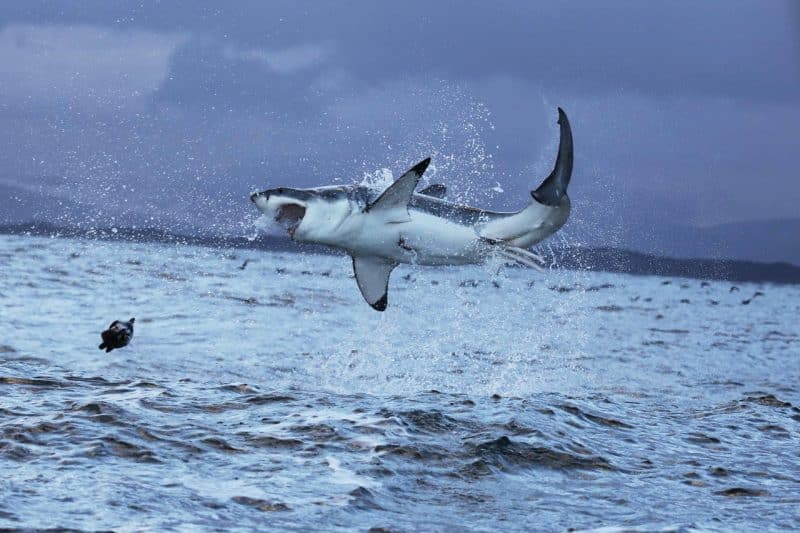
Scientific name: Carcharodon carcharias
Great white sharks belong to the family of mackerel sharks. The Latin name Charcharodon charcharias means “jagged tooth” and refers to the impressive teeth of the predators.
Several rows of wide, triangular incisors protrude from their upper jaw, while lower jaws are narrower and sharper – perfect for holding on to different kinds of prey.
(Yes, this one is known to attack humans).
Are Sharks In The Water Around New York Increasing?

The truth is that sharks have always existed here. The sandbar shark, dusky shark, and sand-tiger shark are the species that are receiving the most media attention. Unregulated fishing from the 1950s to the 1970s caused these sharks to nearly become extinct.
Thankfully the population returned due to greater protections — they are now a prohibited species; you cannot even attack them.
Additionally, researchers maintained bunker fish with the theory that some species would recover on their own if we increased the amount of food in the water. The bunker made a comeback, followed by sharks, bluefin tunas, whales, and dolphins – in other words, it was a huge success.
Shark populations are generally on the decline throughout the world. However, New York is one of the most vibrant cities in the world, and the shark population is expanding. That’s good news, although some might not want to hear that.
However, there were only 73 unprovoked attacks worldwide in 2016. In comparison: there are 4,000 drownings annually in the United States, but still, people continue to swim.
We understand that it’s frightening and that no one wants to be the 74th person on that list. However, with the fear comes others who advocate for shark eradication.
Sharks and Climate Change?
How much hope or dread should you experience?
Sharks and climate change do have a correlation, but it doesn’t have anything to do with numbers. It refers to various sharks rather than more sharks. Blacktip sharks and spinner sharks, for example, are becoming more common in our waters.
Additionally, some of our local species will migrate north due to their unhappiness with the warming water. Let’s examine the 13 unprovoked reported official shark attacks and the three New York beaches with the most attacks.
3 New York Beaches With The Most Shark Attacks
1. Fire Island

Located 32 miles off the coast of New York, Fire Island is home to a well-known black and white lighthouse. Along the Atlantic and Bay sides, there are many beaches. The two latest shark incidents took place off Fire Island.
At Smith Point Beach, the first one occurred around 7:30 in the morning. After knocking them off their board, a 4-foot tiger shark attacked the paddle boarder. They suffered a 4-inch leg laceration, but other than that, they were unharmed.
A 49-year-old Arizona man was wading in waist-deep water at Seaview Beach later that day at about 6:00 pm when an attack occurred. He said that his wrist and buttocks had been bit.
A lifeguard undergoing training was reportedly attacked at Smith Point Beach on Fire Island. The lifeguard suffered a bite to the chest. However, he made a full recovery.
From above, photographer Duncan Weir captured the attacks, where the clear waters provided an excellent view of the midday feeding frenzy. Weir estimated that the school of bunker fish was 200 yards or less off the beach of Atlantique Beach in Islip, New York.
These bait fish near the coast, according to experts from OCEARCH, may be connected to the recent spate of shark attacks and sightings on beaches in New York and New Jersey this summer. Long Island has been the site of at least five shark attacks this summer alone.
Another drone pilot recently captured two great white sharks cooperating to hunt a massive school of fish off the shore of Long Island.
2. Rockaway Beach, Queens

There were two shark attacks in Rockaway Beach. One in 1909 and one in 1953. Both instances featured fishing individuals, one from a boat and the other from shore.
The first was a crew of fishermen who were actively shark-fishing. A man was attacked after falling over when one of the sharks they had caught began to thrash around in the boat.
The other involves a 15-year-old boy who went shark fishing while looking for striped bass. The shark spun around when he grabbed it by the tail and bit him in the leg. After the event, he luckily recovered. The specifics of those instances are as follows:
Incident #1 Rockaway Beach, Queens
Three dentists were fishing for sharks every week when Albert Tyler, a male, slipped overboard and was bitten in the leg on July 24, 1909, at Rockaway Beach in The Broad Channel.
Incident #2 Rockaway Beach, Queens
In Rockaway Beach, Queens, on September 3, 1953, 15-year-old Alan Stevenson Jr. was fishing for sea bass when he hooked an 80-pound sand shark, which bit him in the leg as he attempted to take it by the tail.
3. East River, between Manhattan and Brooklyn

The two attacks on humans by sharks in the East River represent the extremes of shark attacks. One incident included a mere encounter with a shark and left no one hurt, while the other was almost certainly fatal.
A boy named Cole experienced the first. During his brief dip into the water, a shark measuring eight feet long attacked him while boating. The shark was distracted long enough to get him to shore after his friend tossed a rock at it. Although the boy was brought to the police, his back and sides were in such bad shape that it was highly uncertain whether he would survive.
Catherine Beach, the sole female on our list, was the victim of the second assault occurring in 1894. She was swimming in the East River at Woolsey’s Point when she saw a shark and felt it brush past her.
Despite making contact, the shark did not hurt her. Robert Russell claims he saved her that day by helping her into his rowboat. The five-foot-long shark was killed and displayed in Manhattan at the intersection of Ninety-second Street and the East River.
The specifics of those instances are as follows:
Incident# 1 East River, between Manhattan and Brooklyn
Cole, a male swimmer in the East River on August 9, 1878, was bit on the back and sides; the bite was not proven, although it is undoubtedly lethal.
Incident# 2 East River, between Manhattan and Brooklyn
On August 21, 1894, a female swimmer named Catherine Beach was struck by a shovel-nose shark while swimming near Woolsey’s Point in the East River in Long Island City. Fortunately, she escaped unharmed.
Other New York Beaches with Shark Attacks
Coney Island Beach, Coney Island
Visiting beaches and swimming are highly well-liked activities at Coney Island. The most recently reported attack happened in 1874.
Mr. Keatly, of unidentified age, swimming off the shore of Coney Island Beach, close to the site of the former Washington Baths, on July 15, 1874, had an encounter with a shark. He contained lacerations to his groin area.
Gowanus Bay, Brooklyn (east of Prospect Park)
The first reported fatal shark attack in New York occurred on August 8, 1878, when 14-year-old George Gates was swimming. He suffered a “pound of flesh pulled off his hip” and was sewn up, but the next day he passed away from a high fever.
Prince’s Bay, Staten Island
The local news claimed that “a school of sharks had been sighted in the bay” when Charles E. Boone, a man, age 22, was struck on the inside of his leg from the knee towards the thigh while swimming in Prince’s Bay, Staten Island, off the dock of the Mission of the Immaculate Virgin at Mount Loretto.
Plumb Beach (Gateway National Recreation Area) Sheepshead Bay, Brooklyn Gateway National Recreation Area
Male swimmer Thomas Richards was swimming with pals on July 13, 1916, in Sheepshead Bay, Brooklyn. One of his friends warned him of a shark, and as soon as he felt something, his ankle was attacked, leaving a mark.
How to Stay Safe in the Water
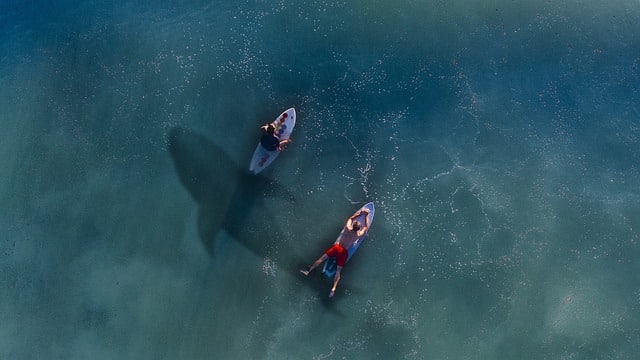
Despite widespread assumption, great white sharks do not aggressively seek people in the water. Scientists have shown that mistaken identity accounts for most unprovoked shark attacks. To put it another way, the shark mistakenly thinks a human is, in fact, a tasty seal.
Always swim with a friend to lessen the chance of being attacked by a shark. Avoid making big splashes and avoid entering the water when you are bleeding.
Sharks are drawn to patterns with solid contrast or vivid colors, so avoid utilizing these. Pay heed to shark warnings; if beaches issue them, stay out of the ocean. Finally, stay away from areas with active fishing communities, seal or sea lion populations, or fishermen.
An excellent probability is that a shark is nearby if you are in the ocean. They are silent and sleek; you can’t smell or see them. As has been shown in this article, sharks attacks in New York are extremely rare but it is not an impossibility!
They would attack much more frequently if they intended to consume humans. Sharks are simply not human-eating machines and don’t like the taste of us.
Bottomline on shark attacks in New York

Shark attacks are incredibly uncommon, and they are much less frequent in New York. According to the Florida Museum of Natural History International Shark Attack Files, there have only been 13 unprovoked attacks in New York between 1860 and 2021.
Out of those four shark attacks, two occurred in the East River and two at Rockaway Beach. Fire Island was the site of the most recent shark attacks, albeit they weren’t reported.
Thank you for reading this article! If you want to meet sharks in a friendly way, read our article on the Best Places to Dive With Sharks!
- Octopus Stuck to Diver’s Back and Won’t Come Off - April 25, 2024
- Magpie Bird Is Reunited with Her Dog Best Friend - April 24, 2024
- Dog Saves Another Dog From Drowning in Fish Pond - April 23, 2024

